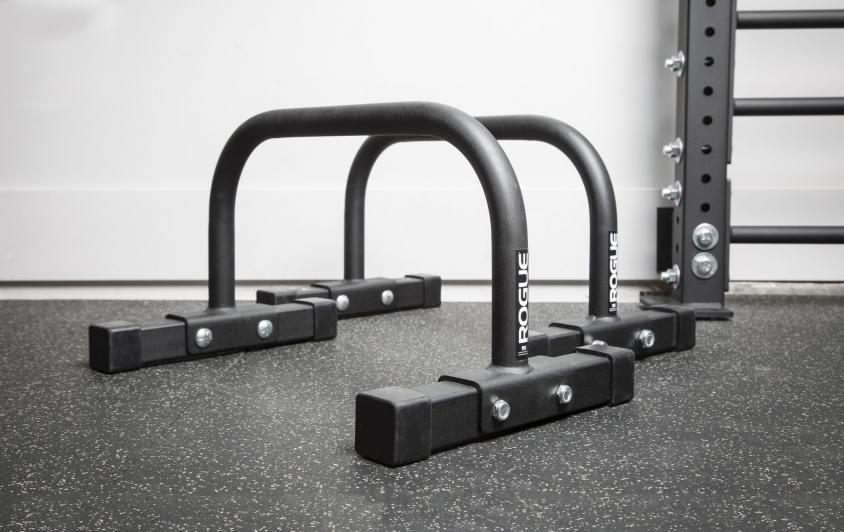The most important requirement for parallette bars is stability. If you are into calisthenics, bodyweight home workout, or hooked with gymnastic training, a pair of high-quality parallettes is the cream and butter of your home gym equipment arsenal. There are many aspects to check before you buy one, however, if it lacks stability or a sure grip for that matter, it’s useless to deal with the rest of its features.
If you need a quick response, in my opinion, the Rogue Bolt Together Parallette Set is the best calisthenics bar for a bodyweight home workout. The Rogue parallette bar is exceptionally strong, has both high lateral and longitudinal stability, and an excellent grip due to its powder-coated finish.
For the short summarized parallettes review check out the table below
Parallette Bar Reviews
Rogue Bolt Together Parallette Set
As usual Rogue did not leave the design of its parallettes to chance either. Its dimensions are perfect, it is tall enough, 14 inches, 25 ”long, and its legs are 15” wide. This not only beats the competition in terms of the number of exercises that can be performed but also stands out for its stability. This latter is greatly enhanced by the high-quality soft rubber ends, which protect the floor from scratches. This allows you to perform exercises that require wider supports, to be carried out safely. You can rest assured the parallette will not slip apart.
They also went absolutely sure with their 1.5 ”standard grip width, which will be ideal for most users.
Rogue uses 2×2″ 11-gauge steel for the crossmembers of its parallettes, and 14 gauge bent pipe for the bars. That basically means this beast was built to last without having to worry about weight limits, even if you put on your heaviest weighted vest, this Rogue parallel bar will handle with ease.
The bolted construction further improves stability. While most parallette manufacturers screw the bars to the top of the crosslegs, in the Rogue parallett the bar ends encircle the crosslegs in a U-shape, thus not loading the bolts. This reduces the chance of them becoming loose, thereby increasing durability and longitudinal stability.

As for the grip, Rogue decided to go heavy-duty as well. Although wood bars give the most comfortable and natural grip, as long as the maximum load capacity is concerned you have no other choice but to use steel. Of course, with a Rogue signature black powder finish that has stood the test of time, designed for serious use. Unless we leave it to rot outside, nothing can really ruin it. Even your grandchildren will be playing with this parallette set.
PROS
- Best value for money and overall
- Very strong structure, made of 11 and 14 gauge steel.
- U shaped joints, bolted construction
- Powder coat finish
- Quality rubber caps on the crossmembers prevent sliding
- 14” off the ground height and 15” wide legs
- Easy to disassemble and store away, portable
CONS
- None
>>CHECK PRICE ON ROGUEFITNESS<<
Tumbl Trak Parallette Bars Blue, Adjustable
This adjustable parallette bar set is really made for those who are serious about calisthenics, have some gymnastics background, or just want to invest for the long term. Mounted in a T-shaped powder-coated steel frame is the 1-1 / 2 ”thick solid beech rod, which provides a very strong and natural, non-slip grip.
The height of the bar can be adjusted in 3 levels, 6 ”, 7.25″ and 8.5 inches from the ground, using two spring buttons that just need to be pulled out, and snapped into the drilled holes.
The crosslegs are 13.5 ”wide, which is longer than the height of the railing, so these parallette bars are extra stable, low-built constructions.
In addition, since they are mainly designed for gymnasts and athletes where the facility is often covered with textile, Tumbl parallettes are velcroed at the bottom, thus enhancing the grip. Don’t ask what if you want to use it on a laminate floor, I think it’s easy enough at home to glue rubber strips in place after removing the velcro.
PROS
- Easily adjustable height in 3 positions with a spring knob
- Commercial quality, powder-coated steel frame
- Solid piece beechwood bars
- Very stable, wide base
- Velcro covered base attaches firmly to closed-loop carpets. 24-inch long work area on the wooden bars provide plenty of space for your bodyweight parallettes routines whether you are a beginner to home workout or a seasoned gymnast
CONS
- Velcro covered base might slide on hardwood or plastic floors.
- Even its highest position 8.5” falls short to the height of taller parallettes, typically being 12+ inches off the ground. This requires advanced core strength which beginners typically lack.
Vita Vibe Wood Parallettes Set 18″ – 24″ Long
Don’t be fooled, this simple wooden parallette can withstand loads up to 250lbs. The most valuable part and the biggest advantage of the Vita Vibe paralletes is the high-quality wooden railing, which is made of hardwood ash, from which most baseball bats are also made. The wooden bar is about 1-1/2” in diameter, which is an ideal grip for most users.
The metal frame is made of thicker steel than it looks, so it will definitely not bend. It also has excellent stability, 2 inches wider than it is high, so we certainly don’t have to worry about it collapsing inward.
Two smaller pieces of rubber prevent the rails from sliding, soft enough not to scour the floor but to hold the parallette in place. Although I would have used a rubber sheet instead of rubber bullets, so the non-slip contact area with the floor would be larger for an even better grip.
A minor design flaw I think is the triangular shape of the metal frame. With this shape, the inner side of the triangle could block the way of the legs during L-sits, shoot throughs, and such. In my opinion, an inverted T-shaped design is best for parallettes.
Overall, this is a high-quality parallel bar made in the USA, backed by a 10-year warranty from the manufacturer.
PROS
- Fairly lightweight
- Good quality wooden bar for best grip
- Sturdy, powder-coated steel base
- 12” wide base, with non-slip rubber pellets
CONS
- Could be higher off the ground, designed 10 inches tall can leave some exercises on the table for beginners
- The triangle design is not the best for parallette bars as it can block the way of the legs
Lebert Fitness Parallettes Push Up Dip Stand
A very lightweight stainless steel parallette bar, weighing only 5 pounds each and still claimed to hold up to 400 pounds. The high-density non-slip foam grips provide a fairly good grip for your bodyweight training. Being 12 ”tall and 25 inches long, it is among the bigger parallette bars, although still a bit smaller compared to the Rogue parallette.
Obviously, don’t expect as much of a lifetime from the foam grip as you can from powder-coated steel or wooden parallettes. By time, even the high-density foam is going to moulder by the sweat of your hands.
The caps at the end of the crosslegs were meant to prevent these planche bars from sliding, however since they are made of hard plastic, there are some complaints about their stability when placed wider apart from each other. However, this is less of a concern when used on carpet.
Overall the Lebert parallette bar is a reasonable option for those who just start out with their home workout and need a reliable tool to complement their bodyweight exercises. It is easy to assemble, lightweight and can get the job done.
PROS
- T-shape design and its 16-inch width provides ample lateral stability.
- This purchase also includes a downloadable PDF Workout Program with Frank Medrano, well-renowned calisthenics, and body-weight training expert.
- Easy to assemble. Comfortable high-density foam grips, that cover almost the entire length of the bars
CONS
- The rubber feet caps are actually plastic, that way in wide positions the Lebert parallettes don’t provide much traction and can slide, especially on hardwood floors. Be careful with wide pushups, handstands or L-sits.
- The foam grip can wear over time by sweaty hands, or if the parallette is stored outside, exposed to sun and rain.
Buying Guide: What to Keep in Mind Before Buying Parallette Bars
Parallettes are among the simplest home fitness equipment. If a longer third is fastened crosswise to two shorter wooden bars, it can already be called a parallette. Yet, in many cases, even such a dead simple product—that can be easily made at home—, oftentimes gets manufactured with such ill-considered frame structure and weak materials, that it turns out to be more useful as a decoration rather than a piece of workout equipment.
Below I have covered some of the most important criteria to look out for before buying paralletes, if you don’t want to disappoint yourself unnecessarily.
Most Common Materials for Parallettes
Wooden parallettes
In a perfect world, I would prefer wooden parallettes, they look the best in my opinion 🙂 One of the bumps though is that they are usually built too low. Because they are light, higher-built frames would be detrimental to stability, the structure would be too weak.
To avoid shaking and twisting of the frame, they would have to use unrealistically thick wooden elements with extra reinforcements, which would take up more space at the expense of portability and easy storage.
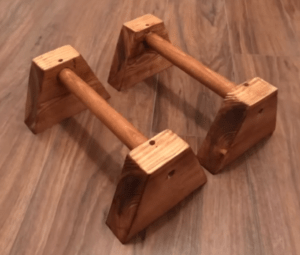
Although you can still do a ton of exercises with them and also, wooden grips are best. However, due to their low build, they are less recommended for calisthenics exercises where ground clearance matters.
Though if it’s already wooden parallettes we talk about, I would definitely make my own anyway, as they are probably the most common DIY gym equipment. You can get every part from your local home depot for pennies.
Honestly, for gymnastic exercises, handstands, L-sit variations, or just for plain pushups, it is the best tool that we can make ourselves.
PVC parallettes
Talk about DIY, there are many who make their parallel bars for home by gluing PVC pipes together. The internet is literally flushed with DIY PVC parallette tutorials, as it is probably the cheapest alternative, and for the price, why not, they are not as bad as cheap.
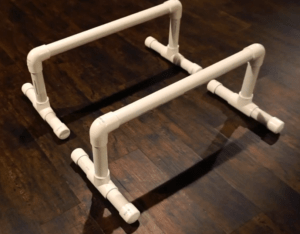
They are even lighter than wood, but the problem is mostly with their slippery grip. In addition, a PVC rod easily bends or breaks under heavier weight. Hence, it is even less possible to be creative with them than with wood. So I would only recommend building a PVC parallette bar if there is no other option.
Steel parallettes
Finally, there is steel, from which the best parallettes are made. With unmatched stability, calisthenics fans can unleash their imagination with all sorts of exercises that require more space and include flips, roll-overs such as “L-sit to planche” and variations.
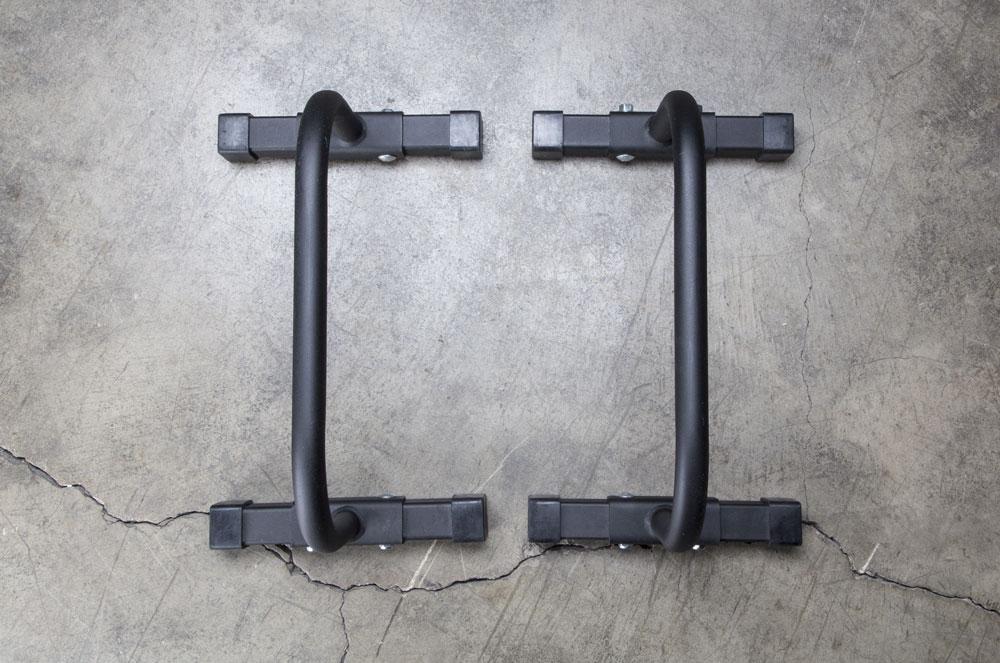
These are the most rigid calisthenics bars. They don’t twist, bend or tremble. If you are a bodyweight training nerd, you could say the only disadvantage of steel to wooden parallettes is their grip as wood has obviously the most natural feel. But that again is rather personal.
Especially if you consider that even this handicap is offset to some degree by quality powder coating most steel parallettes come with as I will outline this later.
All things considered, steel is the most sturdy material for parallettes, not just in terms of being more appropriate for training, but from a durability point of view as well. A quality powder coat finish makes them even corrosion-resistant, so you can leave them out in your backyard without worries.
Weight Capacity
If you are an advanced bodyweight-training warrior, look for a steel calisthenics bar that way you don’t ever need to worry about weight limits or durability.
However, for starters, looking for cheaper parallettes made from aluminum or entirely of wood, it is definitely advisable to check how much load your selected paralette bar can endure.
Don’t blindly trust what its label says, try it out manually if you can. Put on your heaviest weighted vest or ask a friend to stand on it with you. If it doesn’t bend significantly or break, it certainly will handle your home calisthenics workouts with ease.
This is especially important with DIY parallettes. You don’t have to be an advanced athlete to expose your equipment to limit loads and possibly break if it is carelessly assembled, loosely screwed.
Be extra mindful with PVC parallettes. The longer the rod obviously the more bending and with time PVC tends to lose its flexibility and breaks more easily.
Also, the most common mistake made with homemade wood parallettes is to fasten the rod to the supporting beams with just one screw. Wood fibers can tear off the screw, especially if a softer wood is chosen, e.g. pine. Reinforce it with another screw, or just use a thicker one.
I don’t trust gluing either. Glues often dry, then crumble, especially if left exposed to the sun. The last thing you want during a handstand pushup is to break your parallette under you. Gluing only makes sense if the parts are already positioned in a way that they support each other, and fit snugly together without any screw or glue, or dowel. These elements should only serve to enhance rigidity, but not as weight-bearing parts. The structure should already be weight-bearing in itself.
Smooth or Knurled Grip?
If you use chalk or you are already confident in your technique with parallettes you don’t need extra knurling. Though it really depends on what kind of workouts you like to do, however, there’s a reason why most parallettes come without knurling. And that’s because of the nature of the movements these equipment are designed for.
Parallette workouts rather take their effect through constant tension and isometrics instead of dynamic high repetition training, there’s just simply no need for extra knurling.
Okay, but what about high reps common in Crossfit WODs including handstand pushups with a kick? Still no need for knurling. Especially with the types of painted finish knurled parallettes come with. It has no benefits whatsoever, but will only rip off the skin on your palms. That is because, despite the extra rough surface, with a painted finish, the bar is no longer sweat absorbent, which is a key factor for high reps or for any training where grip is of high importance.
And this is why powder coated and especially wooden parellettes became the norm. It’s no coincidence that commercial quality parallettes aren’t knurled.
The only time you need knurling is when lifting or carrying heavy objects. Hence Olympic bars have smooth knurlings, without painting, and this way when used with chalk become sweat absorbent.
Bottom line is, knurling on parallettes is more often than not just a marketing gimmick and doesn’t add value to your bodyweight training.
Non-slip Rubber Caps
I think this is one of the most underrated areas of parallette bars. It is no coincidence that I started with stability. The most common mistake for beginners is to rely too much on the stability of the equipment, instead of their own coordination.
More specifically, their chest and back muscles are not developed enough to hold the parallette bars in place. Instead of creating only a downward force they push laterally, causing the parallettes to either slip apart or worse, buckle. That’s why rubber caps on the cross legs are important. This problem is well masked by dip stations, since, unlike parallettes, their handles are fixed, their distance is given.
However, most manufacturers already addressed this issue. You can hardly find calisthenics bars that don’t have some kind of a non-slip cover on their bottom. The only problem is that oftentimes they use cheap plastic. Which in most cases is too hard to really prevent a sudden slip, especially if we can only practice on a living room parquet, stone, or laminate flooring. On carpets, this is rarely a problem then.
So read customer reviews and carefully check the non-slip features before you buy parallettes. Look for a pair with softer rubber caps.
Crossleg Width
Due to the above-mentioned lack of coordination and strength, not only can our parallettes slide apart but it can also tip over. This can happen especially with higher built parallettes, the lower ones are almost impossible to overturn.
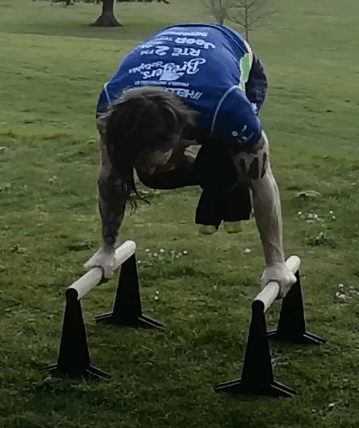
Therefore, the wider the crosslegs—at least half as wide as the height of the bar from the ground—the better the lateral stability of the parallette. That’s pretty no-brainer.
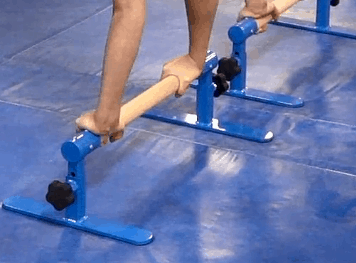
Portability, Storage
Most metal calisthenics bar bases are bolted to the rod so they can be disassembled. The same is less true of wooden parallettes where a metal screw or wooden dowel holds the structure together. But it doesn’t matter, because a bigger parallette with a bent bar won’t fit in most travelers’ suitcases. If you don’t travel, it’s unnecessary to disassemble because it won’t take much less space anyway.
If you want a second-parallette specifically for travel, you have to think about wood-mini bars. These do not need to be disassembled, they are light, they take up very little space. On the other hand, they are especially good for supports, where all you need is a parallel grip, and less of a beefy legroom, e.g. push-ups, handstand exercises.
Ideal Parallettes Height
The height of the parallettes, as already mentioned, depends on our level of training and what exercises we want to do with it.
For pushups or handstand, we need just enough ground clearance that our fist and fingers can grip around the bar. That is different if, for example, we want to sink lower with the pushups, when our shoulders get below our hands or if we want to go shoulder deep with handstand pushups. In this latter case, we need at least so much room that our head can fit in between the parallette bars.
It is also a general suggestion that the more advanced we are, the less space we need between the bar and the floor, so lower parallettes may be sufficient depending on what exercises we do. If, on the other hand, you are a complete beginner, a higher parallette bar is the winner.
Though honestly, apart from portability I don’t see any other reason why you would go with a lower parallette. You can always put something below you to elevate the floor and make exercises more challenging. So it’s easy to scale difficulty with higher parallettes, but less so with lower built parallel bars. With this latter you need to find a block or something stable to elevate the bars.
Here are some exercises for which higher built parallette bars are definitely recommended in case you are new to calisthenics or gymnastics
Pike Push-Ups
Tuck Push-Ups
Dips
Shoot Throughs
L-sit to Tuck
L-sit to Handstand
A Word on Bodyweight Parallettes Workout
A bodyweight workout without a pair of parallettes is like a Rolls Royce without the Spirit of Ecstasy. You would have the suspicion that something just ain’t right.
That is because for the first thought of bodyweight training you would think of jumping jacks, burpees, lunges, and all sorts of exercises with dynamic nature. Training with parallettes, in general, are different as it slows down your workout into mostly isometric holds and positions that really test your nervous system, attention, and willpower.
Training with parallette bars is considered joint-friendly as you mostly use your body weight as resistance instead of external weight. Thus the amount of intensity that will spark adaptation is achieved through specific positions as opposed to free weights or machines.
This kind of isometric training might not cause as much damage in the muscles as a dynamic workout, however it really primes your nervous system and coordination. Much so, that even after a few weeks people report of whopping strength gains and muscle quality improvement. If you’ve ever seen just how jacked gymnasts and calisthenics athletes are, you know what I’m talking about.
Parallettes workout thus is considered the pinnacle of bodyweight training besides training with gymnastic rings and pull-up bars and of course with other sport-specific equipment.
For your next bodyweight workout, consider trying out a few of the most common parallette exercises in the video below:
Conclusion
Well guys, after reading through all the way here, I hope you found this article helpful in picking out the right parallette bar for your home workout.
My personal favorite is the Rogue Bolt Together Parallette Set, due to its remarkable stability, massive construction, and versatility. If you’re planning to only have one parallette, the Rogue bar embodies all the criteria a pair of parallettes should meet, whether you’re a beginner to calisthenics workout or a seasoned gymnast.
Besides that, I also hope that you won’t just put your new parallettes to the corner to dust, but make it a valuable addition to your home gym, as this little piece of equipment can by itself be a game-changer with a little bit of willpower and consistency.

